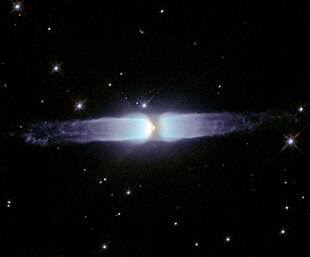Henize 3-401
|
Protoplanetary Nebula Henize 3-401 |
|
|---|---|

|
|
| Photo from the Hubble Space Telescope | |
| AladinLite | |
| Constellation | Keel of the ship |
|
Position equinox : J2000.0 |
|
| Right ascension | 10h 19m 32.5s |
| declination | -60 ° 13 ′ 29 ″ |
| Appearance | |
| Central star | |
| Physical data | |
| distance | 10,000 ly |
| history | |
| Catalog names | |
| PK 285-02 2 • PN G285.1-02.7 • IRAS 10178-5958 | |
The nebula Henize 3-401 , briefly Hen 3-401 , is a protoplanetary nebula that was cataloged by Karl Gordon Henize in 1976. It is located about 10,000 light years from Earth in the constellation Carina . The center of the bipolar nebula is formed by a dying star, which pushes its outer shell into space in two broad, but sharply defined, cylindrical jets .
This nebula is interesting for many astronomers, on the one hand because its jets are so sharply defined, which one tries to explain with strong magnetic fields or with a companion star, on the other hand this star shows how heavy elements are created in a galaxy and distributed in the galaxy, so that stars with planets (and maybe even life) can arise.
The star will likely continue to shed its shell for a few thousand years and then end up as a white dwarf .
Web links
swell
- ^ KG Henize: Observations of southern emission-line stars , bibcode : 1976ApJS ... 30..491H